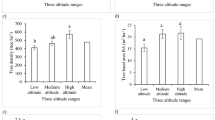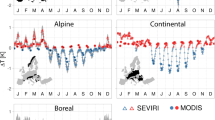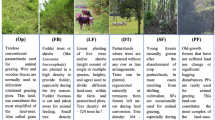Abstract
Pine and oak are the two predominant evergreen forests in the central and western Himalaya between altitudes 1,200 and 2,200 m. The pine is a light-demanding, fire-adapted but fire-promoting species. The surface fires averaging once every 2 or 3 years cause substantial nitrogen losses in pine forest. Pine forest naturally occurs on the driest and rockiest slopes, and has spread greatly under the influence of cutting and burning, replacing oak forest in vast areas. Oak forest is non-inflammable but has suffered a good deal from fire spreading from the pine forest1. Deforestation has also accounted for loss of oak forest1–3, and although the replacement of oak by pine is common1,2, the reverse has not been observed. Our studies indicate that the greater nutrient-conserving ability of pine and the creation of a nitrogen shortage makes it difficult for oak to re-invade areas occupied by pine4–8.
This is a preview of subscription content, access via your institution
Access options
Subscribe to this journal
Receive 51 print issues and online access
$199.00 per year
only $3.90 per issue
Buy this article
- Purchase on Springer Link
- Instant access to full article PDF
Prices may be subject to local taxes which are calculated during checkout
Similar content being viewed by others
References
Champion, H. G. & Seth, S. K. A Revised Survey of the Forest Types of India, 297–299 (Govt of India Publications, New Delhi, 1968).
Dwivedi, B. N. & Mathur, R. S. Working plan for the Naini Tal Forest Division, Kumaun Circle, Uttar Pradesh, 521 (Working Plan Circle, U. P. Forest Department, Naini Tal, 1978–79 to 1987–88).
Singh, J. S., Pandey, U. & Tiwari, A. K. Ambio 13, 80–87 (1984).
Chaturvedi, O. P. thesis, Kumaun Univ., Naini Tal (1983).
Rawat, Y. S. thesis, Kumaun Univ., Naini Tal (1983).
Chaturvedi, O. P. & Singh, J. S. Biomass (in the press).
Negi, K. S., Rawat, Y. S. & Singh, J. S. Can. J. For. Res. 13, 1185–1196 (1983).
Pathak, P. C. & Singh, J. S. Tellus, 36, 44–49 (1984).
Ogino, K. Primary productivity of Japanese forests (eds Shidei, T. and Kira, T.) 172–186 (University of Tokyo Press, 1977).
Bormann, F. H., Likens, G. E. & Melillo, J. M. Science 196, 981–983 (1977).
Vitousek, P. Am. Nat. 119, 553–572 (1982).
Nye, P. H. Plant Soil 13, 333–346 (1961).
Small, E. Can. J. Bot. 50, 2227–2233 (1972).
Grubb, P. J. Ann. Rev. Ecol. Syst. 8, 83–107 (1977).
Gosz, J. R. Ecol. Bull. (Stockholm) 33, 405–426 (1981).
Schlesinger, W. H., Gray, J. T., Gill, D. S. & Mahall, B. E. Bot. Rev. 48, 71–117 (1982).
Robertson, G. P. & Vitousek, P. M. Ecology 62, 376–386 (1981).
Author information
Authors and Affiliations
Rights and permissions
About this article
Cite this article
Singh, J., Rawat, Y. & Chaturvedi, O. Replacement of oak forest with pine in the Himalaya affects the nitrogen cycle. Nature 311, 54–56 (1984). https://doi.org/10.1038/311054a0
Received:
Accepted:
Issue Date:
DOI: https://doi.org/10.1038/311054a0
This article is cited by
-
Atmospheric temperature and humidity demonstrated strong correlation with productivity in tropical moist deciduous forests
Environmental Monitoring and Assessment (2023)
-
Woody species diversity pattern along an elevation gradient of Sainj Wildlife Sanctuary, Western Himalaya, India
Vegetos (2023)
-
Spatio-temporal distribution of broad-leaved Quercus semecarpifolia indicates altitudinal shift in northwestern Himalayas
Plant Ecology (2022)
-
Assessment and monitoring of urbanisation on Himalayan lacustrine environment-a case study in Mirik municipality area
GeoJournal (2022)
-
Changes in soil biochemical properties following replacement of Banj oak forest with Chir pine in Central Himalaya, India
Ecological Processes (2020)
Comments
By submitting a comment you agree to abide by our Terms and Community Guidelines. If you find something abusive or that does not comply with our terms or guidelines please flag it as inappropriate.



